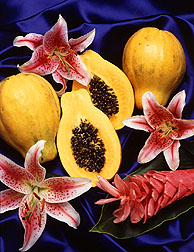|

Research at the U.S. Pacific Basin Agricultural
Research Center's new, state-of-the-art lab and office building focuses on
exotic tropical crops.
|
New USDA Research Facility to Open in
Hawaii
By Marcia
Wood May 29, 2007
HILO, Hawaii, May 29—U.S.
Department of Agriculture scientists who conduct pioneering research on
Hawaii's exotic tropical crops now have a modern facility here in which to
carry out their farmer- and consumer-oriented work. The new facility will
formally open today with an afternoon ceremony.
The $19-million, 35,000-square-foot office and laboratory structure is
part of the
U.S.
Pacific Basin Agricultural Research Center, operated by USDA's Agricultural
Research Service (ARS). ARS is the chief
scientific research agency of USDA.
|

An ARS-developed
hot-forced-air process kills hitchhiking fruit flies, ensuring mainland U.S.
and export markets will continue to welcome the premium fruit. Click the
image for more information about it.
|
|

|
"Our researchers develop new, environmentally friendly ways for
Hawaii's growers and home gardeners to raise premium tropical and subtropical
crops—from bananas to papayas," said ARS Administrator
Edward
B. Knipling.
"USDA research in the Hawaiian Islands dates back more than 100
years," he said. "We're pleased to have this well-designed, state-of-the-art
building in which to continue this tradition of discovery. The research
benefits growers and everyone who enjoys the fruits, vegetables, flowers and
other crops of Hawaii."
Knipling added, "Our research has helped reduce the need for
pesticides, open new markets for Hawaii-grown fresh produce, and unlock secrets
about genes that hold the key to boosting plants' ability to survive drought or
resist attack by disease."
Invited speakers for today's dedication ceremony include U.S. Senator
Daniel K. Inouye; USDA Deputy Under Secretary for Research, Education and
Economics
Merle
Pierson; and ARS Associate Administrator
Antoinette
A. Betschart.
In recent years, collaboration between ARS and university scientists
resulted in papaya plants that resist attack by the devastating papaya ringspot
virus. In other collaborations with university cooperators and growers, ARS
scientists provided leadership, expertise and workable technologies to control
several of the tropical fruit flies that can hinder growers' ability to produce
premium crops for local, mainland U.S. and export markets.
Scientists' teamwork and grassroots-oriented approaches have helped
many of Hawaii's growers use fewer pesticides to protect their crops. Center
Director
Dennis
Gonsalves noted that ARS scientists and colleagues garnered one of USDA's
highest honors for this work.
In other developments, scientists refined what's known as a
"hot-forced-air" treatment for packinghouse use, to ensure that papayas shipped
from Hawaii are free of living fruit flies.
The new scientific facility is located about four miles from downtown
Hilo in a science and technology park managed by the
University of Hawaii-Hilo. The
Honolulu architectural firm of Richard Matsunaga and Associates
designed the new center. Taisei Construction
Corp., Cypress, Calif., built it. Additional facilities for the ARS center
are in the planning stages.